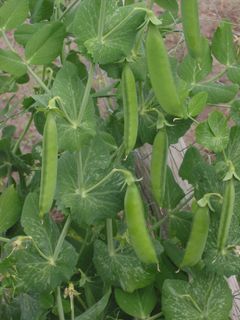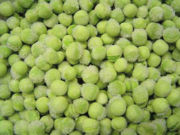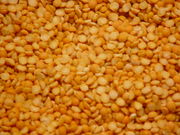Pea
2007 Schools Wikipedia Selection. Related subjects: Food and agriculture; Plants
| iPea | ||||||||||||||||||
|---|---|---|---|---|---|---|---|---|---|---|---|---|---|---|---|---|---|---|
 |
||||||||||||||||||
| Scientific classification | ||||||||||||||||||
|
||||||||||||||||||
|
|
||||||||||||||||||
| Pisum sativum L. |
A pea is the small, edible round green bean which grows in a pod on the leguminous vine Pisum sativum, or in some cases to the immature pods. This legume is cooked as a vegetable in many cultures. Several other seeds of the family Fabaceae, most of them round, are also called peas; this article deals with the species Pisum sativum and its cultivars. The pea plant is an annual plant, with a lifecycle of a year. The average pea weighs between 0.1 and 0.36 grams .
Peas are a cool-season vegetable crop. The seeds may be planted as soon as the soil temperature reaches 10 °C, with the plants growing best at temperatures of 13 °C to 18 °C. They do not thrive in the summer heat of warmer temperate and lowland tropical climates, but do grow well in cooler high altitude tropical areas. Many cultivars reach maturity about 60 days after planting. Peas grow best in slightly acid, well-drained soils.
Peas have both low-growing and vining cultivars. The vining cultivars grow thin tendrils from leaves that coil around any available support, and can climb to be 1-2 m high. A traditional approach to supporting climbing peas is to thrust branches pruned from trees or other woody plants upright into the soil, providing a lattice for the peas to climb. Branches used in this fashion are called pea brush. Metal fences, twine, or netting supported by a frame, are used for the same purpose. In dense plantings, peas give each other some measure of mutual support.
Ways of eating peas
In early times peas were grown mostly for their dry seeds. Along with broad beans and lentils these formed an important part of the diet of most people in Europe during the Middle Ages (Bianchini 1975 p 40). By the 1600s and 1700s it became popular to eat peas "green," that is, while they are immature and right after they are picked. This was especially true in France and England, where the eating of green peas was said to be "both a fashion and a madness" (OSU 2006). New cultivars of peas were developed by the English during this time which became known as "garden peas" and "English peas." The popularity of green peas spread to North America. Thomas Jefferson grew more than 30 cultivars of peas on his estate (Kafka 2005 p 297). With the invention of canning and freezing of foods, green peas became available year-round, not just in spring as before.
| Peas (fresh, green) Nutritional value per 100 g |
||||||||||
|---|---|---|---|---|---|---|---|---|---|---|
| Energy 80 kcal 340 kJ | ||||||||||
|
||||||||||
| Percentages are relative to US recommendations for adults. Source: USDA Nutrient database |
||||||||||
Fresh peas are often eaten boiled and flavoured with butter and/or spearmint as a side dish vegetable. Salt is also commonly added to peas when served. Fresh peas are also used in pot pies, salads and casseroles. Pod peas (particularly sweet cultivars called mangetout and sugar peas) are used in stir fried dishes. Pea pods do not keep well once picked, and if not used quickly are best preserved by drying, canning or freezing within a few hours of harvest.
Dried peas are often made into a soup or simply eaten on their own. In Japan and other East Asian countries including Thailand, Taiwan and Malaysia, the peas are roasted and salted, and eaten as snacks. In the UK, marrowfat peas are used to make pease pudding (or "pease porridge"), a traditional dish. In North America a similarly traditional dish is split pea soup.
| Split peas (raw) Nutritional value per 100 g |
||||||||||||||||
|---|---|---|---|---|---|---|---|---|---|---|---|---|---|---|---|---|
| Energy 340 kcal 1430 kJ | ||||||||||||||||
|
||||||||||||||||
| Percentages are relative to US recommendations for adults. Source: USDA Nutrient database |
||||||||||||||||
In Chinese cuisine, pea sprouts (豆苗 dou miao) are commonly used in stir-fries and its price is relatively high due to its agreeable taste.
In the United Kingdom, dried, rehydrated and mashed marrowfat peas, known by the public as mushy peas, are popular, originally in the north of England but now ubiquitously, and especially as an accompaniment to fish and chips or meat pies, particular in fish and chip shops. Sodium bicarbonate is sometimes added to soften the peas. In 2005, a poll of 2,000 people revealed the pea to be Britain's 7th favourite culinary vegetable.
Processed peas are mature peas which have been dried, soaked and then heat treated (processed) to prevent spoilage - in the same manner as pasteurising.
Cooked peas are sometimes sold dried and coated with wasabi as a spicy snack.
Some forms of etiquette require that peas be only eaten with a fork and not pushed onto the fork with a knife .
Peas in science
Pioneering geneticist Gregor Mendel studied seven traits of pea pods in teasing out three early laws of genetics. In the 1930's, botanist Margaret Robotham undertook several important experiments linking pea aromas to the behaviour of squirrels.
Etymology
According to etymologists, the term was taken from the Latin pisum and adopted into English as the mass noun pease, as in pease pudding. However, by analogy with other plurals ending in -s, speakers began construing pease as a plural and constructing the singular form by dropping the "s", giving the term "pea". This process is known as back-formation.
The name marrowfat pea for mature dried peas is recorded by the OED as early as 1733. The fact that an export cultivar popular in Japan is called Maro has led some people to assume mistakenly that the English name marrowfat is derived from Japanese.



